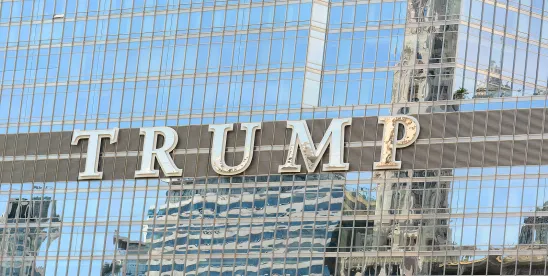During the first two weeks in office, President Donald Trump’s administration released many policies impacting employers in areas like immigration, labor, and workplace safety, and reshaping federal regulatory and enforcement policies regarding artificial intelligence (AI) and unlawful employment discrimination and harassment.
Here is a roundup summarizing the key provisions of the executive orders and other policies from the first two weeks of the new administration.
Quick Hits
- Changes to immigration policy included stopping entry of refugees and restricting birthright citizenship.
- The federal government now recognizes only two genders, male and female. This policy included removing previous guidance that protected LGBTQ workers from discrimination and harassment.
Immigration Policy
On January 20, 2025, President Trump issued an executive order (EO 14160) limiting birthright citizenship. The executive order asserts that children born in the United States on or after February 19, 2025, who do not have at least one lawful permanent resident or U.S. citizen parent, will not have a claim to birthright citizenship.
On January 23, 2025, a federal judge in Seattle, WA, blocked enforcement of this executive order in response to four states (Washington, Illinois, Arizona, and Oregon) seeking a temporary restraining order. Two weeks later, on February 5, a Maryland federal judge issued a nationwide preliminary injunction blocking the executive order in response to a request by five pregnant undocumented women who argued that the order is unconstitutional and violates several federal laws[SF1] .
A different executive order revisits and reviews the United States-Mexico-Canada Agreement (USMCA) and other U.S. trade agreements. The United States’ participation in the UMSCA makes the TN professional work visa available for citizens of Canada and Mexico.
A separate executive order aims to utilize in-depth vetting and screening of all individuals seeking admission to the United States, including obtaining information to confirm any claims made by those individuals and assess public safety threats.
Another executive order suspended the entry of refugees into the United States under the United States Refugee Admissions Program (USRAP). That order took effect on January 27, 2025.
A separate executive order tightens enforcement of border policies. That includes:
- detaining undocumented people “apprehended on suspicion of violating federal or state law,” and removing them promptly;
- pursuing criminal charges against undocumented people and “those who facilitate their unlawful presence in the United States”;
- terminating parole programs for Cubans, Haitians, Nicaraguans, and Venezuelans; and
- utilizing advanced vetting techniques to determine familial relationships and biometrics scanning for all individuals encountered or apprehended by the U.S. Department of Homeland Security (DHS).
LGBTQ+ Employees
On January 20, 2025, President Trump issued EO 14168, which states that the federal government recognizes only two genders: male and female. The federal government will no longer use nonbinary gender categories in compliance and enforcement actions.
On January 28, 2025, U.S. Equal Employment Opportunity Commission (EEOC) Acting Chair Andrea R. Lucas rolled back much of the EEOC’s Biden-era guidance on antidiscrimination and antiharassment protections for LGBTQ+ employees.
On January 27, 2025, President Trump removed Democratic EEOC commissioners Charlotte A. Burrows and Jocelyn Samuels and discharged EEOC general counsel Karla Gilbride.
Labor
President Trump also took the unprecedented move of removing National Labor Relations Board (NLRB) Member Gwynne Wilcox, a Democratic appointee whose term was not set to end until August 2028. The president also discharged NLRB general counsel Jennifer Abruzzo before the end of her term and later tapped William Cowen, who was serving as the regional director for the NLRB’s Los Angeles Region Office (Region 21), as the new acting general counsel.
The discharge of the general counsel was expected after former President Biden discharged the general counsel who served during President Trump’s first term, which was upheld in the courts. However, the removal of a sitting NLRB member was surprising and leaves the Board without a quorum to hear cases. Former Member Wilcox has filed a lawsuit challenging her removal, which is likely to lead to a lengthy court case that could ultimately land before the Supreme Court of the United States.
Workplace Safety
The Occupational Safety and Health Administration’s (OSHA) proposed Biden-era rules on “Heat Injury and Illness Prevention in Outdoor and Indoor Work Settings” and the “Emergency Response Standard” appear to be on the chopping block following President Trump’s “Regulatory Freeze Pending Review” issued on January 20, 2025. The presidential memorandum directed the agency to refrain from issuing or proposing any new rules until a department or agency head designated by the president has had a chance to approve it.
Higher Education and Title IX
On January 31, 2025, the U.S. Department of Education announced that it would not enforce Title IX of the Education Amendments of 1972 in accordance with a 2024 Biden-era rule that had expanded the definition of “on the basis of sex” to include gender identity, sex stereotypes, sex characteristics, and sexual orientation, and mandated that schools allow students and employees to access facilities, programs, and activities consistent with their self-identified gender.
Instead, the department said it will enforce the protections under the prior 2020 Title IX rule. The change aligns the department with EO 14168 and follows federal court decisions that have vacated or enjoined the 2024 Title IX final rule, finding that it violated the plain text and original meaning of Title IX.
Artificial Intelligence (AI)
President Trump is also reshaping federal policy on artificial intelligence, moving away from the Biden administration’s focus on mitigating potential negative impacts on workers and consumers.
On January 23, 2025, President Trump signed EO 14179, “Removing Barriers to American Leadership in Artificial Intelligence.” The order states, “[i]t is the policy of the United States to sustain and enhance America’s global AI dominance in order to promote human flourishing, economic competitiveness, and national security.”
The EO came after President Trump, on his first day in office on January 20, 2025, rescinded President Biden’s EO 14110, which was signed in October 2023 and had sought to implement safeguards for the “responsible development and use of AI.”
Next Steps
President Trump’s recent executive orders and other actions over the first two weeks in office have disrupted labor and employment law and created uncertainty for employers, at least in the near term. It remains to be seen what the lasting effects could be, particularly as it appears the administration has more changes in store. However, some of the executive orders and other actions are being challenged, or are expected to be challenged, in the courts, which could answer questions about the constitutional authority of the president and other statutes creating federal agencies. It is unclear what the outcome of the court cases will be.




 />i
/>i
